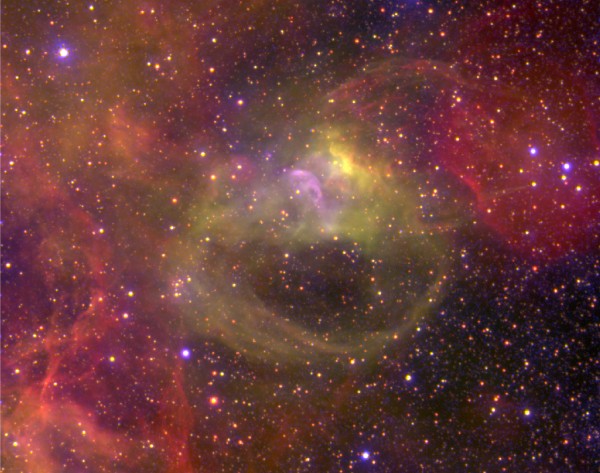
|
Credit & Copyright: Y. Naze, G. Rauw, J. Manfroid, J. Vreux
(Univ. Liege),
Y. Chu (Univ. Illinois),
ESO
Explanation:
Blossoming in nearby galaxy the
Large Magellanic Cloud (LMC), this
gorgeous nebula is energized by radiation and winds from
a massive star whose surface temperature approaches 100,000 degrees.
The
composite color image
from the European Southern Observatory's
Melipal telescope
resolves details in the energetic nebula, with emission
from helium atoms in blue hues, oxygen atoms in green, and
hydrogen atoms in red.
While
emission nebulae
generally show the familiar red light from
ionized hydrogen atoms - hydrogen atoms with
their
electrons stripped away - ionized helium atoms are tracers
of even higher energy interactions.
The intriguing filaments of helium emission make this and other
recently studied emission nebulae most
exceptional.
A Wolf-Rayet star,
the massive star powering this nebula,
created a cosmic bubble
with stellar winds in the early stages
of its life.
Part of the bubble is still apparent as the large arc
in the lower portion of the image.
The area pictured is about 150 light-years across.
Have you seen today's:
THEMIS Image of Mars?
|
January February March April May June July August September October November December |
| ||||||||||||||||||||||||||||||||||||||||||||||||
NASA Web Site Statements, Warnings, and Disclaimers
NASA Official: Jay Norris. Specific rights apply.
A service of: LHEA at NASA / GSFC
& Michigan Tech. U.
Based on Astronomy Picture
Of the Day
Publications with keywords: emission nebula - LMC - Wolf-Rayet star
Publications with words: emission nebula - LMC - Wolf-Rayet star
See also:
- APOD: 2025 December 9 Á The Heart of the Soul Nebula
- APOD: 2025 November 24 Á Apep: Unusual Dust Shells from Webb
- APOD: 2025 September 19 Á The NGC 6914 Complex
- APOD: 2025 September 10 Á The Great Lacerta Nebula
- APOD: 2025 July 21 Á Cats Paw Nebula from Webb Space Telescope
- APOD: 2025 July 16 Á The Rosette Nebula from DECam
- APOD: 2025 July 5 Á Ou4: The Giant Squid Nebula
